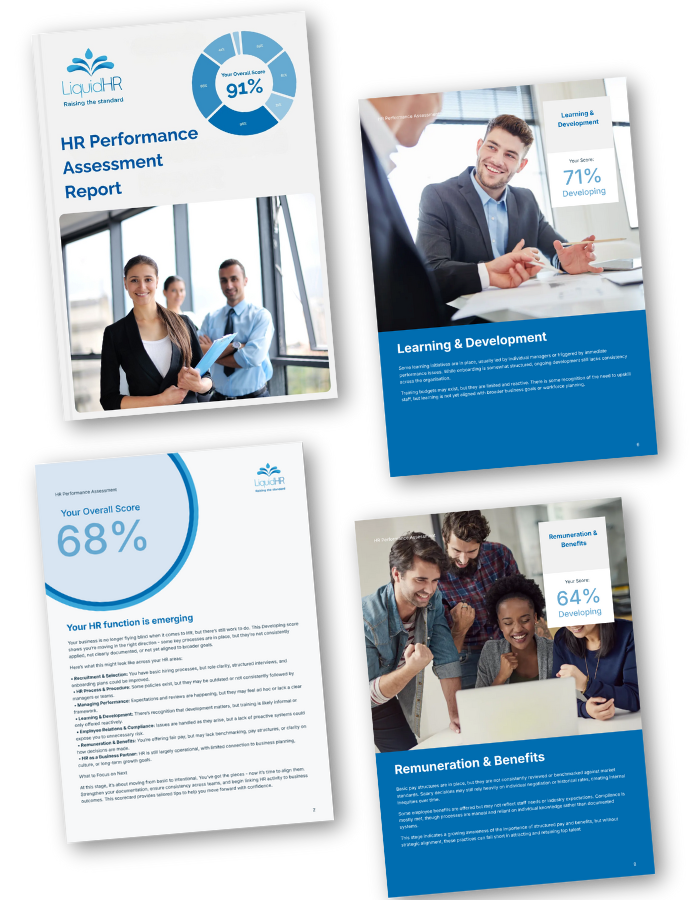Is HR Outsourcing Right for Your Business? 5 Signs It’s Time to Make the Move

Introduction
Managing human resources in-house might seem manageable, until it’s not. As your business grows, HR becomes more complex, time-consuming, and legally risky. According to MicroSourcing, HR outsourcing can reduce employment costs by up to 70% and help free your internal team to focus on strategy instead of admin.
But how do you know when it’s the right time to outsource HR? If you’re asking that question, you’re likely already feeling the pressure.
Here are 5 key signs it may be time to consider HR outsourcing and how it could help your business grow more efficiently and compliantly.
1. You’ve Grown to 15+ Employees (and Still Don’t Have a Dedicated HR Team)
Once your team hits a certain size, HR responsibilities begin to scale quickly. From onboarding to managing leave entitlements and handling sensitive employee issues, these tasks can no longer be managed “on the side” by a business owner or office manager.
Why this matters: Without dedicated HR support, you risk errors, missed compliance obligations, and burnout for whoever’s juggling HR alongside other responsibilities.
2. You’re Expanding into New States or Markets
Entering new territories, whether interstate or internationally, brings new awards, regulations, and compliance requirements. Each state or region may have unique rules for minimum wage, break entitlements, and safety obligations.
Why this matters: Outsourced HR teams bring local expertise to ensure you meet every regional requirement without delay or penalty.
3. You’re Struggling to Keep Up with Fair Work or Employment Law Changes
In Australia, the Fair Work Act continues to evolve, especially around casual employment, psychosocial hazards, and gender equality. Staying across it all can feel like a full-time job (because it is).
Why this matters: Outsourced HR providers stay ahead of legal updates, providing proactive compliance guidance so you’re always protected.
4. HR Admin Is Taking Time Away from Strategy
Business owners and senior leaders should focus on strategy, growth, and client relationships, not employee files, leave tracking, and policy updates.
Why this matters: HR Outsourcing frees up your time while still ensuring a professional, consistent employee experience.
5. You’ve Had (or Fear) a Staff Dispute or Legal Issue
Workplace complaints, investigations, or unfair dismissal claims can happen in any business especially when HR processes are inconsistent or undocumented.
Why this matters: An outsourced HR team gives you access to experienced advisors and compliant processes, reducing the risk of costly disputes.
So, Is HR Outsourcing Right for Your Business?
If any of the above situations sound familiar, HR outsourcing isn’t just a nice-to-have, it’s a smart business decision. Outsourcing gives you access to specialist knowledge, reduces risk, and improves your ability to scale confidently.
The Right to Disconnect: What Australian Employers Need to Know Before August 2025

From 26 August 2025, all Australian employers (big and small) will be required to comply with the new “Right to Disconnect” laws. While large businesses have already been operating under the new rules since 2024, small businesses now have just weeks left to prepare.
This legislative change marks a significant shift in how after-hours contact is managed in Australian workplaces. As flexible and remote work arrangements continue to dominate, HR professionals and business leaders must strike a new balance between responsiveness and employee wellbeing.
In this blog, we unpack what the law means, who it applies to, and how you can prepare your teams and policies in time.
What Is the Right to Disconnect?
Under changes introduced in the Fair Work Legislation Amendment (Closing Loopholes) Act 2023, the Right to Disconnect gives employees the legal right to refuse to monitor, read, or respond to work-related contact outside of their usual working hours, unless that refusal is unreasonable.
Key elements include:
- Applies to both employer-initiated and third-party (e.g., client) contact.
- Refusal to respond must not be unreasonable.
- If disputes arise, they can be escalated to the Fair Work Commission for resolution.
Who Does It Apply To?
- Large businesses (15+ employees): Already subject to the law since 26 August 2024.
- Small businesses (<15 employees): Will need to comply by 26 August 2025.
It applies to all national system employees, with protections becoming part of the National Employment Standards (NES)—meaning they cannot be excluded from contracts or enterprise agreements.
What’s Considered “Unreasonable”?
The legislation recognises that some after-hours contact may be legitimate. Whether an employee’s refusal to respond is “unreasonable” depends on factors such as:
- The reason for the contact (e.g., genuine emergency)
- The employee’s role, level of responsibility, and salary
- Whether the employee is on-call or being compensated for availability
- The frequency and timing of such contact
- Personal circumstances or health impacts
In practice, a manager texting a junior team member late at night about non-urgent matters is likely to be unreasonable, whereas a senior executive paid for 24/7 availability may be expected to respond in urgent cases.
What Should Employers Do Now?
To comply and avoid legal risk HR leaders should take proactive steps to embed these protections into workplace culture and operations.
1. Update Workplace Policies
Your policies should:
- Explicitly recognise the Right to Disconnect
- Define expectations around working hours and after-hours contact
- Clarify when exceptions may apply (e.g. emergencies, on-call roles)
- Address use of communication tools (email, messaging apps, etc.)
2. Review Employment Contracts
Ensure there is:
- No language requiring unreasonable 24/7 availability
- Clarity on working hours and expectations for contact
3. Train Managers and Leaders
Line managers are often the ones initiating contact. Equip them to:
- Understand the legal obligations
- Respect boundaries across teams
- Use scheduling tools to delay non-urgent messages
4. Monitor Workload and Culture
Right to disconnect violations often stem from overwork or unrealistic deadlines. Make sure your culture supports reasonable workloads and performance expectations.
5. Create Clear Communication Protocols
Adopt systems that:
- Limit unnecessary out-of-hours communication
- Offer guidance on appropriate channels (e.g., when to use Slack vs SMS vs email)
Risks of Non-Compliance
If an employee believes their right is being violated, they can:
- Raise a workplace grievance, which must be handled under your internal policies.
- Apply to the Fair Work Commission, which can issue binding orders.
Non-compliance can expose your business to:
- Legal costs and reputational damage
- Penalties if an order is breached
- Increased attrition and burnout
Conclusion
The Right to Disconnect isn’t just a legal requirement, it’s an opportunity to strengthen your organisation’s approach to work-life balance, wellbeing, and respectful leadership.
HR teams that prepare now will not only meet their compliance obligations but also build trust and loyalty with their people.
The Changing Face of Employee Benefits in Australia: What Workers Really Want.

Gone are the days when a decent salary and a ping-pong table in the breakroom were enough to keep employees happy. In 2025, Australian workers want more…more flexibility, more support, more meaning.
With a competitive labour market, rising cost-of-living pressures, and a growing focus on wellbeing and purpose, the benefits employers offer can make or break their ability to attract, engage, and retain top talent.
So, what do employees in Australia really value in 2025? Let’s take a look at the new benefit trends shaping the future of work.
1. Flexibility Is Non-Negotiable
Flexible and hybrid work are no longer perks – they’re expected.
A recent ABS survey found that over 70% of professionals now work remotely at least part of the time, and many say they would turn down roles that don’t offer flexibility (ABS Working Arrangements).
What employees want:
- Choice over when and where they work
- Compressed workweeks or 9-day fortnights
- Flexible start and finish times
- Job sharing and part-time options for all levels
2. Wellbeing: Beyond Free Fruit
Employee wellbeing has matured from generic wellness programs to more targeted, personalised support.
Leading employers are offering:
- Expanded EAPs including mental health coaching and digital access
- Wellbeing allowances (e.g. for gym, counselling, or meditation apps)
- Burnout prevention policies such as email curfews or wellness leave
- Support for carers and parents, including subsidised childcare
Many employees now prioritise mental health benefits over free snacks or social events.
3. Financial Wellbeing Support
In the face of inflation and housing affordability issues, employees want support with financial resilience.
What’s gaining traction:
- Employer-paid financial coaching or planning services
- Salary advance options or earned wage access platforms
- Discounted mortgage advice or rental support programs
- Super top-ups beyond the 12% minimum
4. Career Growth Is King
Australian workers, particularly Gen Z and Millennials, want meaningful development, not just promotions.
Key benefits in this space:
- Professional development budgets (including self-directed learning)
- Study leave and support for certifications or postgraduate study
- Internal mobility programs to explore new roles or teams
- Mentoring, coaching, and peer learning groups
5. Values-Aligned Perks
Today’s employees want to work for companies that stand for something. Benefits that reflect your culture and values are powerful differentiators.
Emerging trends:
- Volunteering leave or paid impact days
- Climate-conscious benefits (e.g. green transport incentives)
- Inclusive family leave policies (supporting all family structures)
- DEI programs with measurable outcomes, not just lip service
What Should Employers Do Now?
To stay competitive:
- Survey your workforce to understand what they actually value.
- Audit your benefits offering—what’s outdated? What’s missing?
- Communicate clearly—employees often don’t use benefits simply because they don’t know what’s available.
- Tailor benefits by life stage or need—one-size-fits-all is out.
Are Your Employment Contracts Outdated? Essentials for Australian SMEs

Employment contracts are often seen as a “set and forget” document, but with the pace of change in Australian employment law, that approach is now a serious compliance risk.
In 2025, recent updates to the Fair Work Act, the National Employment Standards (NES), and Modern Awards have reshaped employer obligations, particularly around flexibility, workplace rights, and termination processes.
If your employment contracts haven’t been reviewed in the past 12–18 months, there’s a good chance they’re missing critical terms or worse, exposing your business to legal claims.
Let’s break down what Australian SMEs need to include in their contracts to stay compliant and competitive.
Why Employment Contracts Matter
A well-drafted employment contract protects both parties by clearly outlining:
- Role expectations
- Pay and conditions
- Legal entitlements
- Confidentiality and IP
- Termination terms
But with new minimum standards now embedded in law, contracts must be updated to reflect not only the current obligations, but also your workplace practices.
Must-Haves for Every Australian Employment Contract
1. Compliant Wording on the National Employment Standards (NES)
The NES provides 11 minimum entitlements—including paid leave, public holidays, notice of termination, and flexible work rights. Contracts cannot reduce or contract out of these entitlements.
Ensure your contract states clearly that the employee’s rights under the NES will be upheld in full.
2. Award Coverage (or Not)
Many roles are covered by a Modern Award. Failing to reference this (or wrongly claiming a role is award-free) is a common and costly mistake. For a deep dive into award classification and entitlements, explore Liquid HR’s 2025 Modern Award Guide.
Specify:
- Whether a Modern Award applies
- The name of the Award and classification level
- Any Award-specific terms you’re applying (e.g., annualised salary)
3. Right to Disconnect Clause
From August 2025, all Australian employees will have a protected Right to Disconnect, meaning they can refuse unreasonable contact outside working hours.
Include a clause acknowledging this right and clarifying when contact may still be required (e.g. on-call roles or emergencies).
4. Clear Terms Around Flexibility and Remote Work
Post-pandemic, flexibility is a norm. But if your contract doesn’t clearly set out expectations for remote or hybrid arrangements, you risk disputes.
Outline:
- Primary work location
- Any remote/hybrid working arrangements
- Employer’s right to change or review flexible arrangements
5. Pay and Superannuation Clarity
Avoid vague or outdated pay clauses—especially if offering annualised salaries or allowances.
Include:
- Base rate and pay frequency
- Superannuation obligations – now 12%
- Award or enterprise agreement references if applicable
6. Leave Entitlements
Spell out the leave types (annual, sick, long service, etc.), but ensure they reflect NES minimums.
Also consider including:
- Family and domestic violence leave (paid for all employees since August 2023)
- Parental leave eligibility and policies
- Any additional paid leave your company offers (e.g., wellness or study leave)
7. Termination and Notice Periods
Contracts must not undermine NES minimum notice. But you can (and should) outline:
- Specific notice periods (often longer than NES minimums)
- Grounds for summary dismissal
- Probation terms (usually 3–6 months)
8. Confidentiality, IP, and Post-Employment Obligations
Include clauses covering:
- Protection of intellectual property created during employment
- Confidentiality and privacy
- Post-employment restraints (e.g. non-solicitation, non-compete)
Common Contract Mistakes SMEs Make
- Relying on template contracts from years ago
- Using vague job descriptions or failing to define duties
- Failing to account for award classification and pay rates
- Omitting flexibility, hybrid work or remote work clauses
- Not updating super rates or new NES entitlements
What To Do Now
- Audit your current employment contracts to spot outdated terms or inconsistencies.
- Review applicable Modern Awards, especially if roles have changed.
- Work with an HR or legal expert to create tailored templates by role type.
- Train your managers and admin teams to issue contracts consistently and legally.
Need help staying compliant?
Stay compliant with our updated Modern Award Guides – covering SCHADS, Retail, Hospitality, Fast Food, Restaurant, and Clerks awards. Each guide includes key July 2025 updates.












